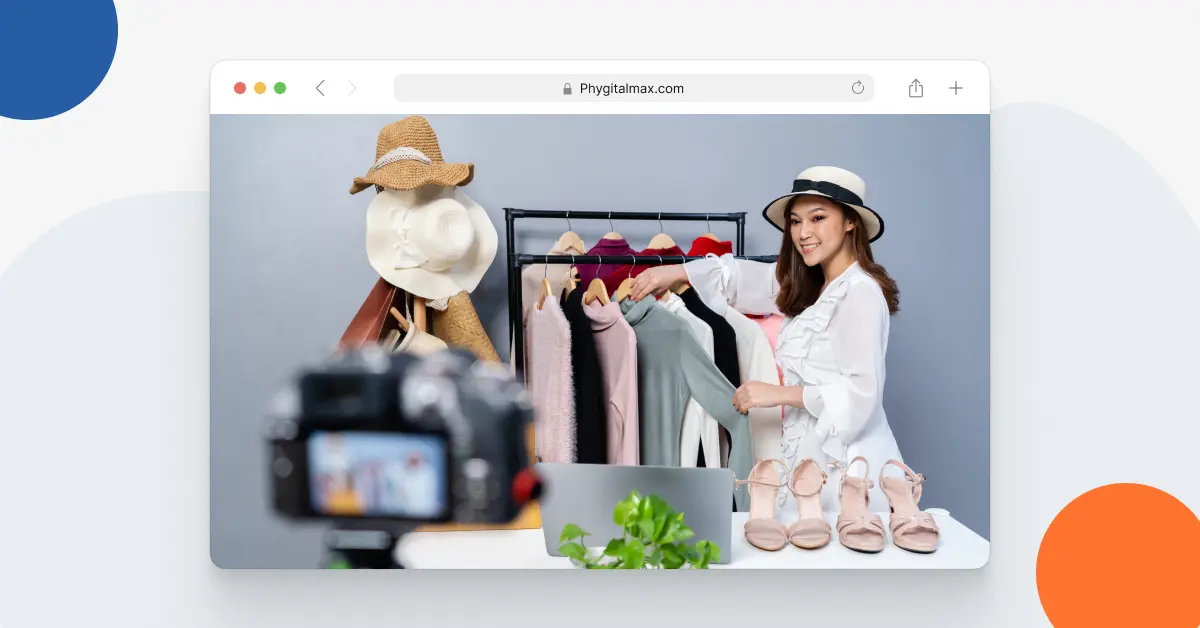New technologies and changing customer preferences are revolutionizing the clothes retail sector. As the digital world grows, the future of retail Industry and future of fashion retail demand that retailers innovate by blending online and in-store shopping experiences. According to Statista, the e-commerce fashion industry’s compound annual growth rate (CAGR) is tipped to grow 14.2% between 2017 and 2025.
This blog discusses the future of fashion retail, including digital marketing, AR, VR, CX, and in-store and online shopping.
Online Shopping Trends
Online shopping has transformed physical stores. The expansion of e-commerce firms and the simplicity of phone purchases have increased online fashion site traffic. Some important trends involving the future of fashion retail are –
- Mobile Commerce: Retailers are improving their websites and apps for mobile commerce as more consumers buy on their phones.
- Social commerce: Instagram and TikTok let users shop from posts and make purchases in the app, making this a big part of shopping.
- Sustainable Fashion: Customers are becoming more environmentally concerned, driving the need for ethical and sustainable clothes.
The impact of phygital video on the B&M experience in fashion
Physical stores remain vital despite the growing number of individuals purchasing online. They are evolving from being locations where people just went to purchase items to places where people could have experiences. Global e-commerce is expected to reach a staggering $27.15 trillion in revenue by 2027, growing at a 14.7% CAGR from 2020 to that year. The key to B&M’s success in the fashion retail sector is creating unique, compelling experiences that aren’t available online.
- Experience-Driven Stores: Stores focus on in-store events, such as fashion shows, individual styling sessions, and interactive displays.
- Integration of technology: Contactless payment choices, smart mirrors, and digital changing rooms make shopping more enjoyable and make things run more smoothly.
- Phygital Integration: The mixing of digital and physical aspects, known as “phygital,” allows online and offline purchases.
Customer Experience (CX) in Fashion Retail
Today, marketing is about consumer emotion. Stores spend money on tools and plans to boost CX and make sure that every contact is designed to make customers pleased.
The customer experience will play a major role in the future of fashion retail.
- Omnichannel Consistency: Giving customers the same shopping experience on all platforms, like in-person places and online shops.
- Personalized marketing: This marketing improves the buying experience by using data analytics to make suggestions and offers tailored to each customer.
- 24/7 Customer Service: AI-powered robots answer questions and resolve difficulties.
Personalized Shopping Experiences
Personalization is a key way to keep customers coming back and get them involved. By adapting the buying experience to each person’s tastes, stores can greatly increase customer happiness and loyalty. One of the best things about the future of fashion retail is that the personalized shopping experience will be even better in the coming days.
- AI and Machine Learning: These technologies look at how customers behave to give them personalized content and product suggestions.
- Loyalty programs: Giving customers rewards based on how they shop and what they like makes them more loyal and likely to buy from you again.
- Customization Options: People who seek unique experiences especially enjoy it when they can personalize goods like clothes with their initials or, even better, get items tailored to fit them perfectly.
Augmented Reality (AR) in Fashion
The way people shop for clothes is changing a lot because AR is connecting online and real encounters. The future of fashion retail is going to be completely different.
- Virtual Try-Ons: AR lets people try on clothes and accessories electronically so they can get a good idea of how they’ll look without having to go to a shop.
- Interactive displays: AR displays in shops can display product details, style advice, and virtual fashion shows, making shopping more enjoyable.
- Better Product Visualization: AR lets customers see full views and images of products, which helps them make decisions.
Omnichannel Marketing
Omnichannel marketing ensures constant and simplified consumer interactions, making it vital to fashion shopping’s future.
- Keep the company’s message and experience consistent throughout social media, online, and in-store.
- Data integration merges consumer data from multiple platforms to create a unified customer profile, enabling more targeted marketing.
- Online-to-in-store shopping should be seamless for customers (BOPIS).
How phygital video shopping is creating personalized customer experiences?
A new retail trend, phygital video shopping combines the benefits of online and offline buying. This is definitely going to be the future of fashion retail. Live video shopping combined with in-store experiences lets retailers connect with consumers, provide tailored recommendations, and demonstrate products.
- Real-Time Engagement: During live video buying, buyers can talk to speakers, ask questions, and get answers right away.
- Product Demonstrations: Video shopping lets you show off goods in more depth, showing their features and benefits.
- Personalized Customer Experiences: Hosts can make shows more interesting and personal by adapting them to the tastes of each watcher.
The Role of AR and VR in Phygital Video Shopping for Fashion
AR and VR are very important for improving physical video shopping because they add realistic and interactive features that keep customers interested. These AR and VR are going to be the future of fashion retail.
- Live Video AR Try-Ons: Customers can see how items look on them in real time when AR try-on features are added to live video buying events.
- Virtual stores: Virtual reality (VR) can be used to make virtual showrooms where buyers can look at sets and play with goods in a real-life setting.
- Engaging Elements: AR and VR can make video shopping more engaging by adding things like clickable points, detailed product views, and virtual help.
Building an Omnichannel Fashion Retail Strategy with Phygital Video
Phygital video shopping is an important part of a successful digital strategy because it makes the customer trip smooth and interesting. It is essential to get an idea about the future of fashion retail –
- Integrating marketing campaigns: This means coordinating video shopping events with other marketing efforts like email campaigns and social media ads.
- Consistent company messaging: Making sure that the word about the company stays the same across all media and places of contact.
- Utilization of Customer Data: Using information from video shopping sessions to guide marketing plans and make future exchanges more personal.
Conclusion
The future of fashion retail will be tech-driven, focusing on seamless, customized, and engaging purchasing experiences. Online shopping, AR, VR, and physical video shopping may help shops adapt to consumers’ evolving requirements. Integrating these technologies boosts customer satisfaction, drives fashion industry growth, and fuels innovation. If you are planning to increase brand awareness for your fashion brand, you need the help of Phygitalmax. To grow your brand and be successful Phygitalmax can provide you with complete guidance.








